elevations Two-dimensional views of three-dimensional figures given from the top, front, or sides. Elevations usually include measurements and a scale.
empty set A set containing no elements. Also know as the null set. Symbols used to denote this set are,
 .
.
Equal Fractions Property If the numerator and denominator of a fraction are both multiplied ( or divided ) by the same nonzero number, then the resulting fractions are equal.

This example works because 3/3 is another name for one, and any number when multiplied by one retains its original value.

This example works because 3/3 is another name for one, and any number when multiplied by one retains its original value.
equally likely outcomes Outcomes in a situation where each outcome is assumed to occur as often as every other outcome.
Ex: 3x + 7 = 19
equation of the form x + a = b An equation in which an unknown number x is added to a known number a, resulting in a known number b.
Ex: x + 8 =16
equation of the form ax = b An equation in which the unknown number x is multiplied by a known number a, resulting in a known number b.
Ex: 4x = 64
equation of the form ax + b = c An equation in which an unknown number x is multiplied by a known number a, then added to a known number b, resulting in a known number c.
Ex: 2x + 7 = 27
equation of the form ax + b = cx + d An equation in which the same unknown number x is multiplied by numbers a and c and added to known numbers b and d, resulting in equal values.
Ex: 5x + 8 = 3x + -10
Estimation Principle If two numbers are nearly equal, then when one is substituted for the other in a computation will be nearly equal.
Euclid A Greek mathematician, who lived about 300 B.C., famous for his Elements, a collection of theorems and problems that forms a logical system of geometry. Euclid also wrote on conic sections, optics, algebra and numbers. He proved that the number of primes is infinite. He founded the first school of mathematics at Alexandria. For more than 2,000 years, Euclidean geometry was the only kind taught in schools.
evaluating an expression Finding the value of an algebraic expression by substituting a value for the variable(s) and then applying the order of operations, PEMDAS (parentheses, exponents, multiplication and division from left to right, and addition and subtraction from left to right).
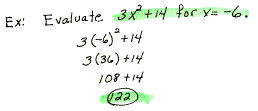

evaluating a numerical expression Working out the arithmetic in a numerical expression. The order of operations, PEMDAS (parentheses, exponents, multiplication and division from left to right, and addition and subtraction from left to right), must be followed when evaluating any numerical expression
extended ratio A sequence of three or more numbers representing the relative sizes of the numbers (or quantities).
Ex:
This 30, 60, 90 degree triangle has angles which follow a 1:2:3 ratio because 60 is two times bigger than 30, and 90 is three times bigger than 30.
exterior angle An angle formed by two lines and a transversal whose interior contains no points between the two lines. An angle which forms a linear pair with an angle of a given polygon.
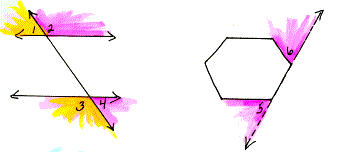
Above you see angles 1, 2, 3, 4, 5, and 6 are all exterior angles.
NOTE: If the two lines that are cut by the transversal are parallel, then the alternate exterior angles, 1&4, 2&3, will be congruent

Above you see angles 1, 2, 3, 4, 5, and 6 are all exterior angles.
NOTE: If the two lines that are cut by the transversal are parallel, then the alternate exterior angles, 1&4, 2&3, will be congruent
exterior of a circle The set of points at a distance greater than the radius from the center of the circle. It's just everything not in or on the circle itself.
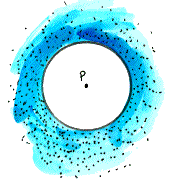

exterior of a figure When a figure separates the plane into two parts, one bounded and one not, the unbounded part.
exterior of an angle A nonzero angle separates the plane into two sets of points. If the angle is not straight, the non-convex set is the exterior of the angle.


 Remember that b and c are called the means, and that the product of the means is always equal to the product of the extremes in any proportion.
Remember that b and c are called the means, and that the product of the means is always equal to the product of the extremes in any proportion. Labels:
Math terms glossary
Labels:
Math terms glossary

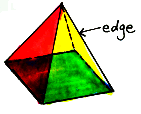

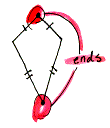


 Previous Article
Previous Article
